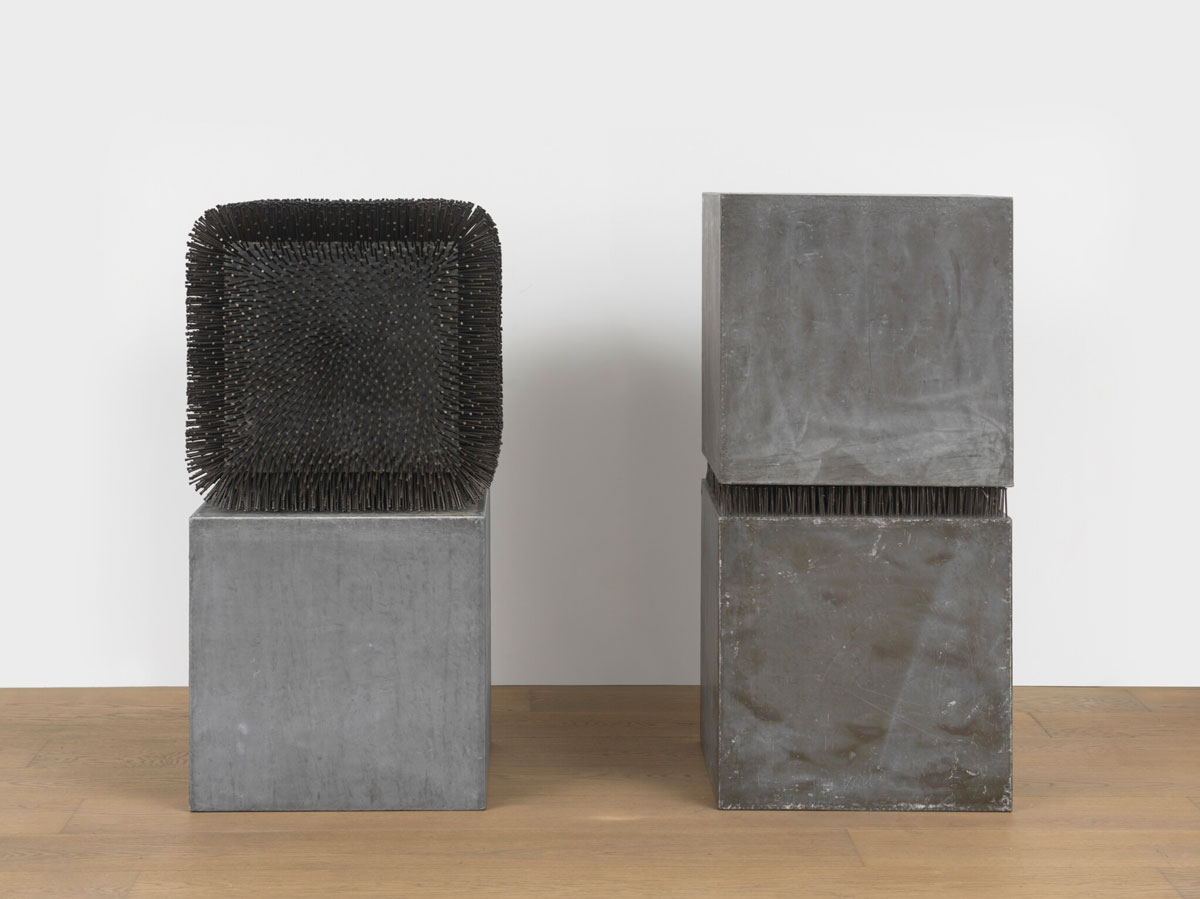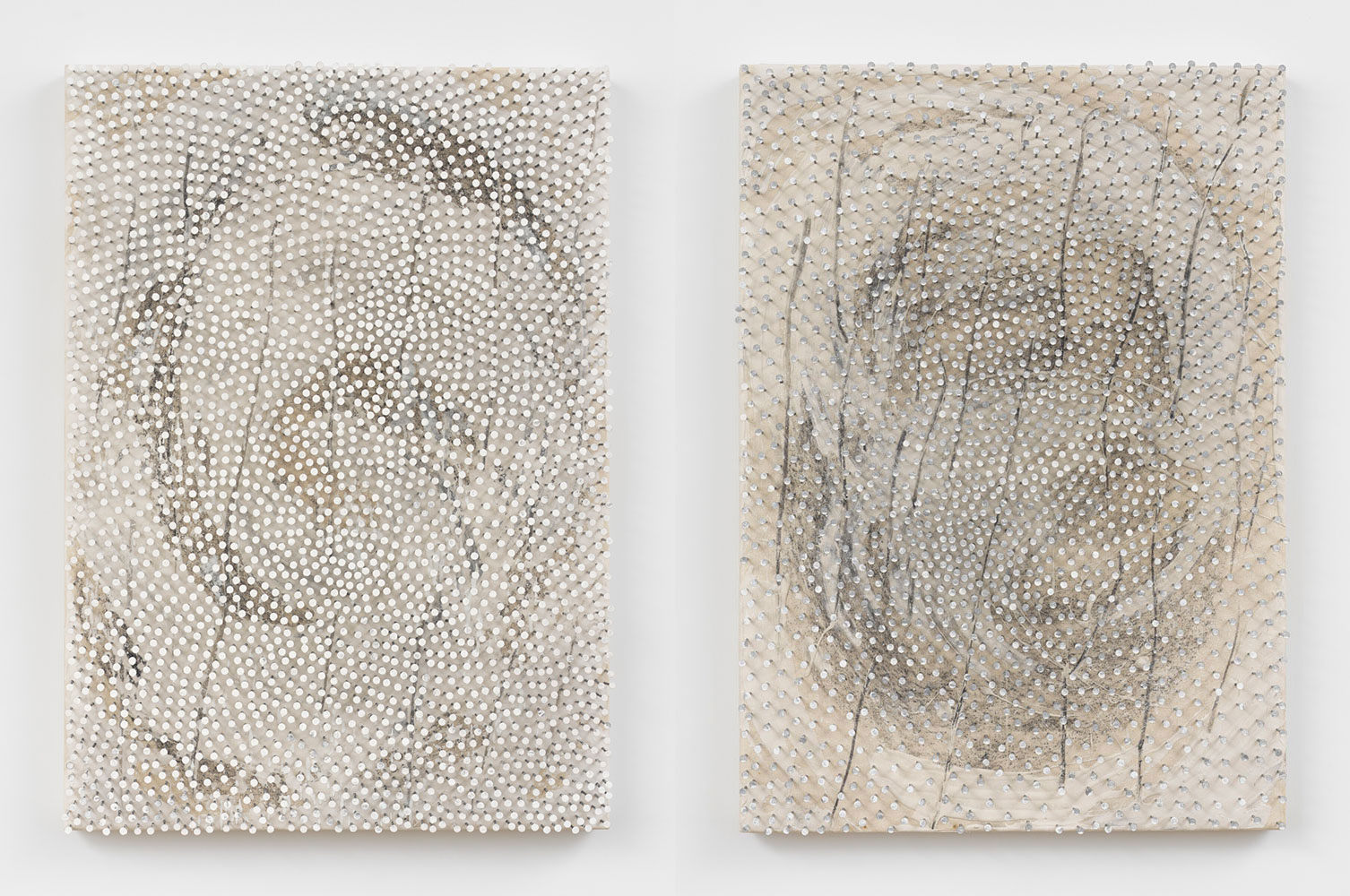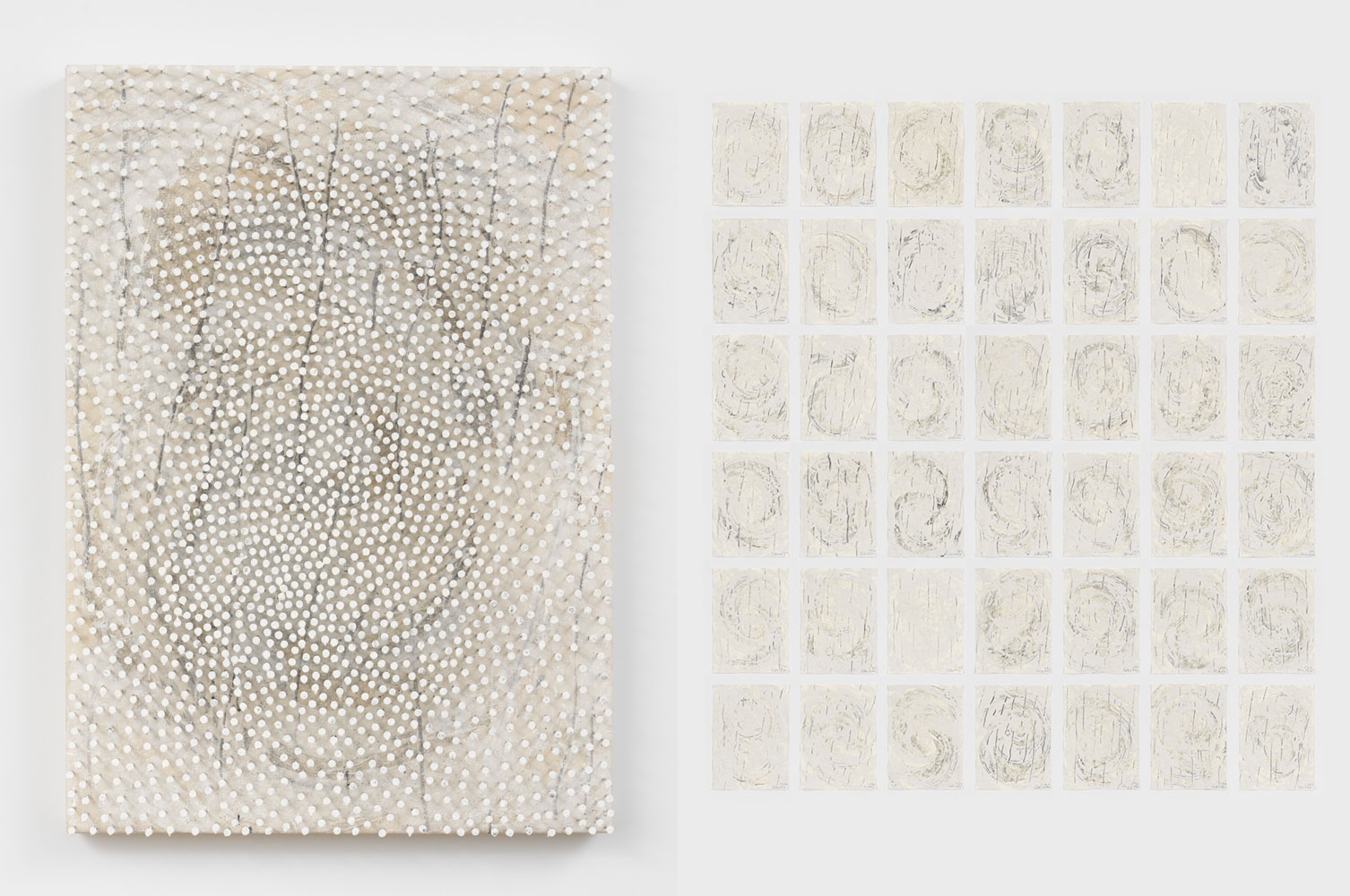PREVIEW: Günther Uecker-Shields
 Günther Uecker is best known for his signature explorations of the aesthetic possibilities of the hammer and nail. In the 1960s, he was part of the Gruppo Zero movement, which called for simplified forms. Uecker hammers dense groups of nails into canvases and ready-made objects, resulting in undulating, metallic surfaces that walk the line between abstract compositions and three-dimensional sculptures. His works also include kinetic and electrical elements, along with materials including ash, sand, stone, glass, string, cloth, and even tree trunks.
Günther Uecker is best known for his signature explorations of the aesthetic possibilities of the hammer and nail. In the 1960s, he was part of the Gruppo Zero movement, which called for simplified forms. Uecker hammers dense groups of nails into canvases and ready-made objects, resulting in undulating, metallic surfaces that walk the line between abstract compositions and three-dimensional sculptures. His works also include kinetic and electrical elements, along with materials including ash, sand, stone, glass, string, cloth, and even tree trunks.
By Dimitris Lempesis
Photo: LGDR Gallery Archive
After the Gruppo Zero’s dissolution in 1966, Günther Uecker’s work incorporated aspects of conceptual and land art, and he began designing stage sets for operas. In 2020, he embarked on his series Lichtbogen, minimalist paintings of radiant blue-and-white arcs. The exhibition “Shields” reflects on Günther Uecker’s seven-decades-long engagement with nails, paint, and graphite as potent symbolic materials and processual tools. The presentation brings together all nine paintings in the artist’s most recent series “Shields” (2022), a new and related series of works on paper, and a pivotal but rarely seen sculpture from 1967. The exhibition illuminates Uecker’s recent series of nail reliefs from which the presentation takes its name. Featuring bold graphite marks, eddies of white paint, and skeins of nails, these canvases are among the artist’s most revealing and restrained, advancing his experimentation with the format and finding expression in our contemporary age. Uecker created the “Shields” during his continued pandemic isolation. Alone in the studio, he progressively worked on each composition, enacting a process of opening up and healing, and finding introspection and relief. The more limited application of paint in these paintings, on both canvas and nails, results in panels that are exposed, raw. Uecker’s work directly reckons with social and environmental crises, channeling the emotional imprints of pain and grief as well as spiritual fulfillment and joy. His act of hammering harkens back to his experience as a teenager during the final years of the Second World War, when he helped to protect his family home from Russian soldiers by nailing planks to the windows as barricades. The artist envisioned the dual aspects of a shield as he developed these nail paintings: armor that can serve as both protection and a representation of oneself, bearing a personal emblem or family crest. “Swabs” (2022), comprising a grid of forty-two paintings on paper, connects the two floors of the exhibition. Created this year alongside Uecker’s nailed “Shields”, these paintings are characterized by vertical strokes and atmospheric spirals of graphite intersected and obscured by currents of paint. The work’s title refers to the rapid process of collecting DNA and revealing essential elements of oneself. Each mark here translates and elaborates elements of Uecker’s hammering process, integrating bodily traces into the painted surfaces. Where the depth of his nail works offers kinetic choreographies of light and shadow, in the present work, the artist achieves an equally resonant effect through shallower interplays of transparency and opacity. The intense, spectral presence of Swabs is exemplary of Uecker’s ability to conceive work that seems to transcend materiality itself. The two-part sculpture “Kubuskubus” (1967), offers a distilled dialogue about materiality and perception. One part of the work comprises a voluminous metal cube poised on top of another, held uncannily aloft by a layer of densely hammered nails. The second element likewise features two vertically arranged cubes; but here, the upper cube consists of thousands of nails hammered into lead. Though the forms are the same scale, they achieve radically different optical effects. The artis says that “Kubuskubus” references, in part, Kazimir Malevich’s nonrepresentational painting “Black Square: (1913)., Uecker translates Malevich’s square into four box-like elements, each presenting a unique relationship to light, surface, and gravity. Giving the structures a vertical orientation, he references the dimensions of the human body, creating a dialectic with the viewer.
Günther Uecker was born on March 13, 1930, in Wendorf, Germany. Between the years 1949 and 1953, he studied painting at the Kunsthochschule Berlin-Weissensee and then continued his artistic education under Otto Pangkok at the Kunstakademie Düsseldorf, Germany, in 1955. Throughout the 1950s, Uecker sought out philosophies that he felt preached simplicity and purity, such as Buddhism, Taoism, and Islam. His fascination with purification rituals, such as the Gregorian chant, led him to engage in his own rituals of repetition, such as the hammering of nails for extended periods of time. By 1957, he had begun to integrate nails, and around 1960, corks and cardboard tubes, into the surface of his canvases to create relief works. These reliefs are more akin to sculpture than painting: their jutting nails and other objects create patterns of light and shadow upon the surfaces of the canvases. Starting in 1960, Uecker shifted his methodology from utilizing a precise, mathematical order to one that was more organic and irregular, often integrating kinetic and electrical elements, such as rotating discs and lightboxes. In 1961 Uecker joined Gruppo Zero, founded by Heinz Mack and Otto Piene, with whom he had participated in the exhibition “Das rote Bild” in 1958. The exhibition took place in the studios of Mack and Piene, which were located in the yard of an old factory building in Düsseldorf. Mack, Piene, and Uecker formed the core of the Gruppo Zero, though it also included a number of artists unified by their desire to work outside of the prevailing movements Tachisme and Art Informel. Uecker, along with other Zero artists, wanted to return art to a “zero base,” giving it a fresh start after World War II. The artist hoped viewers of his art would be open to new levels of perception and consciousness through a concrete experience with the work. Uecker’s own philosophy was greatly influenced by a meeting with John Cage in 1959, during which he garnered the idea that the artist need only set a work in motion and wait for reality to complete it. Much of Uecker’s work derives from this principle and encourages viewer intervention or participation. Throughout the 1960s, Uecker inserted nails into pieces of furniture, such as television sets, chairs, and pianos. After the Gruppo Zero dissolved in 1966, Uecker shifted to creating works influenced by body, Conceptual, and Land art, and during the 1970s he even executed several stage designs for operas, including Ludwig van Beethoven’s “Fidelio” and Richard Wagner’s “Parsifal” and “Lohengrin”. Uecker taught from 1974 until 1995 at the Kunstakademie Düsseldorf and was promoted to professor in 1976. With Otto Piene, Heinz Mack and Mattijs Visser he founded in 2008 the international ZERO foundation. The foundation has the complete ZERO archives from three Düsseldorfer artists as well as documents and photos from other related artists.
Photo: Günther Uecker, Kubuskubus, 1967, Nails, metal, and wood in two parts, Each part: 47 1/4 x 23 5/8 x 23 5/8 inches (120 x 60 x 60 cm), © Günther Uecker, © Artists Rights Society (ARS), New York / VG Bild-Kunst, Bonn, Courtesy the artist and LGDR Gallery
Info: LGDR Gallery (Dominique Lévy, Brett Gorvy, Amalia Dayan, and Jeanne Greenberg Rohatyn), 909 Madison Avenue, New York, NY, USA, Duration: 15/11-23/12/2022, Days & Hours: Tue-Sat 10:00-18:00, https://lgdr.com/

Right: Günther Uecker, Shield, 2022, Paint, nails, and graphite on canvas laid down on wood, 41 3/8 x 29 1/2 inches (105.1 x 75 x 10.5 cm), © Günther Uecker, © Artists Rights Society (ARS), New York / VG Bild-Kunst, Bonn, Courtesy the artist and LGDR Gallery

Right: Günther Uecker, Swabs, 2022, Graphite and paint on paper in 42 parts, Each: 13 3/4 x 9 13/16 inches (35 x 25 cm), © Günther Uecker, © Artists Rights Society (ARS), New York / VG Bild-Kunst, Bonn, Courtesy the artist and LGDR Gallery
